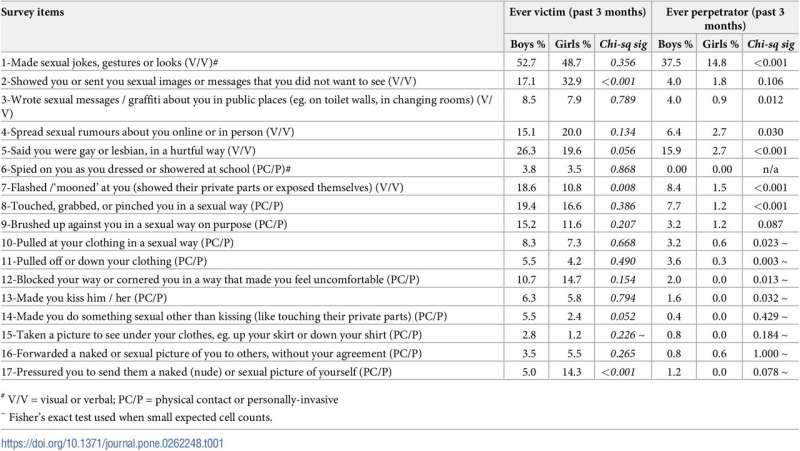Individual victimization and perpetration items by gender. Credit: Sweeting et al., 2022, PLOS ONE, CC-BY 4.0 (creativecommons.org/licenses/by/4.0/)
Sexual harassment in secondary schools is pervasive: two in three teens (64.7 percent) surveyed in Scotland reported visual and verbal harassment, and one in three (34.3 percent) reported personally invasive behaviors, in the last three months. Students are uncertain about the acceptability of many behaviors, and some are normalized, according to the research, published in the open access journal PLOS ONE. Effective interventions are needed to change attitudes and behaviors which can persist into later life.
There is little research on the prevalence of sexual harassment among young people, and even less on adolescent perceptions of what counts as sexual harassment. Researchers at the University of Glasgow conducted a survey of 638 students aged 13-17 in three secondary schools between June and November 2019. Students were asked about their experiences of instigating or experiencing 17 behaviors in the past three months.
Sexual jokes, gestures or looks were most commonly experienced—by around half of respondents. The second most commonly reported behavior was being shown or sent unwanted sexual images. Girls were more likely to be sent or shown sexual images (33 percent of girls vs 17 percent of boys) and were also more likely to be pressured into sending them (14 percent of girls vs 5 percent of boys). Meanwhile, boys reported higher rates of being flashed or mooned at (19 percent of boys vs 11 percent of girls).
Focus groups with 119 students followed the survey, to discuss perceptions around acceptability of these behaviors. This revealed that some low-level visual or verbal behaviors such as making sexual jokes were acceptable within friendship groups, or in online gaming chat settings. There were rarely explicit discussions about boundaries; instead, judgements were made by 'feeling' a behavior was ok and/or 'knowing the person'.
The researchers highlight that harassment is often unrecognized, normalized or perceived as not worth reporting, underlining the importance of helping young people recognize how low-level sexual harassment can play into norms and attitudes that encourage more serious behaviors.
The authors add: "Sexual harassment is common and often seen as 'normal' among teenagers at school. Our study agrees with others in this respect, but, importantly, also highlights the uncertainties which teenagers may feel around whether many behaviors generally regarded as representing sexual harassment are acceptable or not. These results have implications for the design of school-based sexual harassment interventions which, if effective, could generate long-lasting changes in attitudes and behaviors."
More information: Sweeting H, Blake C, Riddell J, Barrett S, Mitchell KR (2022) Sexual harassment in secondary school: Prevalence and ambiguities. A mixed methods study in Scottish schools. PLoS ONE 17(2): e0262248. doi.org/10.1371/journal.pone.0262248
Journal information: PLoS ONE
Provided by Public Library of Science






















